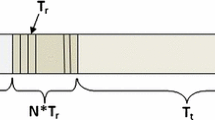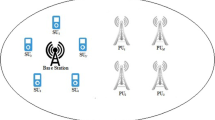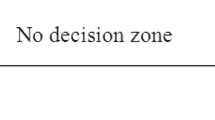Abstract
In this paper, we investigated the important influence of reporting frame format in cooperative spectrum sensing (CSS), which was ignored in existing works. Firstly, we proposed a comparison between soft and hard combination schemes based on the practical reporting frame format. Furthermore, we derived the closed-form expression of optimal cooperative nodes in soft combination under the practical reporting condition. The theory analysis and simulation results show that the results of existing works would not hold when considering the real reporting frame format, and the optimal performance of CSS would be obtained when the sampling time equals to the reporting time.





Similar content being viewed by others
References
Mach, P., & Becvar, Z. (2017). Energy-aware dynamic selection of overlay and underlay spectrum sharing for cognitive small cells. IEEE Transactions on Vehicular Technology, 66(5), 4120–4132.
Zhang, H. J., Nie, Y. N., Cheng, J. L., Leung, V. C. M., & Nallanathan, A. (2017). Sensing time optimization and power control for energy efficient cognitive small cell with imperfect hybrid spectrum sensing. IEEE Transactions on Wireless Communications, 16(2), 730–743.
Chen, C., Berry, R. A., Honig, M. L., & Subramanian, V. G. (2017). Competitive resource allocation in HetNets: The impact of small-cell spectrum constraints and investment costs. IEEE Transactions on Cognitive Communications and Networking, 3(3), 478–490.
Zhang, W., & Letaief, K. (2009). Cooperative communications for cognitive radio networks. Proceedings of the IEEE, 97, 878–893.
Zhang, W., Mallik, R. K., & Letaief, K. B. (2009). Optimization of cooperative spectrum sensing with energy detection in cognitive radio networks. IEEE Transactions on Wireless Communication, 127, 5761–5766.
Peh, E. C. Y., Liang, Y.-C., Guan, Y. L., & Zeng, Y. (2009). Optimization of cooperative sensing in cognitive radio networks: A sensing-throughput tradeoff view. IEEE Transaction on Vehicular Technology, 58(9), 5294–5299.
S. M. Mishra, A. Sahai, and R. W. Brodensen, (2006). Cooperative sensing among cognitive radios. In Proceedings on IEEE international conference communication (ICC) (pp. 1658–1663).
G. Ganesan, and Y. Li, (2005). Cooperative spectrum sensing in cognitive radio networks. In Proceedings on IEEE DySPAN (pp. 137–143).
A. Ghasemi, and E. S. Sousa, (2007). Optimization of spectrum sensing for opportunistic spectrum access in cognitive radio networks. In Proceedings on 4th IEEE consumer communication networking conference (CCNC) (pp. 1022–1026).
A. Ghasemi, and E. S. Sousa, (2005). Collaborative spectrum sensing for opportunistic access in fading environments. In Proceedings on IEEE DySPAN (pp. 131–136).
Y. Tani, and T. Saba, (2010). Quantization scheme for energy detector of soft decision cooperative spectrum sensing in cognitive radio. In IEEE global telecommunications conference (pp. 69–73).
Liang, Y.-C., Zeng, Y., Peh, E. C. Y., & Hoang, A. T. (2008). Sensing-throughput tradeoff for cognitive radio networks. IEEE Transactions on Wireless Communication, 7(4), 1326–1337.
Althunibat, S., Palacios, R., & Granelli, F. (2012). Performance optimization of soft and hard spectrum sensing schemes in cognitive radio. IEEE Transactions on Wireless Communication, 16(7), 998–1001.
Jeon, W. S., Lee, D. H., & Jeong, D. G. (2013). Collaborative sensing management for cognitive radio networks with reporting overhead. IEEE Transactions on Wireless Communication, 12(2), 595–605.
IEEE Std. 802.11, (1999). Wireless LAN medium access control (MAC) and physical layer (PHY) specifications for 802.11a and 802.11b.
Acknowledgements
The work is supported by the National Natural Science Foundation of China (Nos. 61702543, 61271254, 71501186 and 71401176), the Natural Science Foundation of Jiangsu Province of China (Nos. BK20141071, BK20140065), the 333-high-level talent training project of Jiangsu Province of China (No. BRA 2016542).
Author information
Authors and Affiliations
Corresponding author
Rights and permissions
About this article
Cite this article
Zhu, L., Yao, C. & Wang, L. The Optimization of Combination Scheme in Cooperative Spectrum Sensing Based on the Practical Reporting Frame Format. Wireless Pers Commun 102, 3009–3019 (2018). https://doi.org/10.1007/s11277-018-5322-4
Published:
Issue Date:
DOI: https://doi.org/10.1007/s11277-018-5322-4




